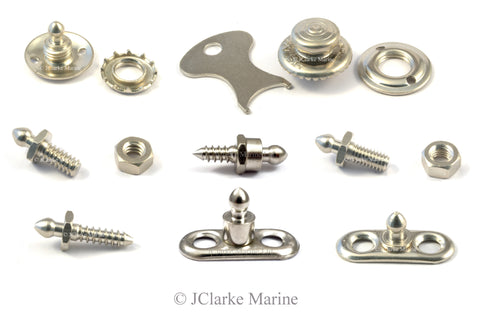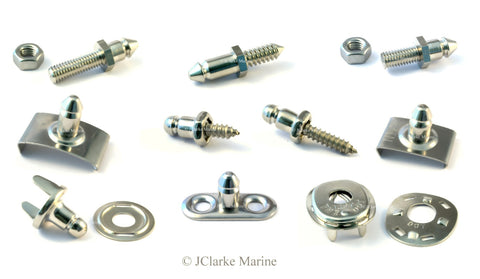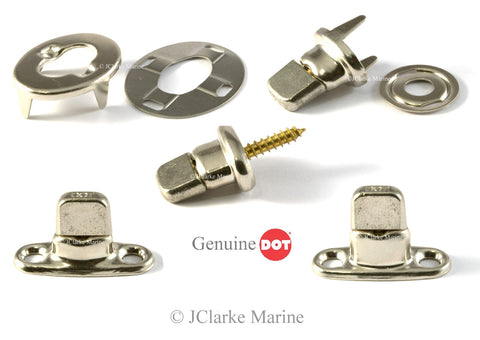The ultimate guide to canopy fasteners, here I will explain the different types, how each are used and how to fit them.
Simply click on the picture for detailed fastener guides or scroll on down for brief descriptions. Well worth reading.
Lift the dot fasteners
Press snap fasteners
Turnbutton fasteners
Tenax Fasteners
YKK Snad fasteners
"Do you sell those twisty turnbuckle fasteners?" is a question quite frequently asked. I have to admit , I do sell turnbutton fasteners and if you want to call them turnbuckle fasteners , I do sell those also and many other types of fasteners which then opens a can of worms for the buyer. We will leave turnbuckles in the rigging sector for now.
There are many types of canopy fasteners and not only are they used on boat canopies but also classic/vintage car hoods, vintage coach pram hoods, military satchels, narrowboats and marquees to name a few but in this blog I am going to chat about the most commonly used fasteners in the market today. This includes Lift the Dot , Turnbutton, Tenax and Snap fasteners. In the picture below you will see a few pieces from each range. Through the guide you will hear me using terminology such as socket/eyelet and stud. Socket will refer to the female part of the fastener or the part you see on the top of your canopy and stud is generally the part you fix to the deck or floor. Studs can be threaded, self taper or simply have holes positioned on them so you can fix with screws, rivets or bolts.
There are pros and cons to each of the fasteners above and I will try to describe the function, fitting and durability as best I can.
Lift the DOT
Lift the Dot
Intro
Lift the dot fasteners were first invented to hold curtains back on horse driving carriages. They then moved into the military industry used for keeping satchels bags close and also gun holsters shut. Due to their strength and durability they elevated onto the marine and automotive market. Lift the dots are unique as they are locked on three sides and can only be opened by "lifting the dot" on one side. This is always marked with a dot on the socket. The prongs on the socket come in two lengths to accommodate different thickness of material. There are many types of studs also, again to entertain the thickness of material or the material they are being fixed too.
Specification
Made from heavy gauge brass,Nickel plated, Phosphor bronze spring used in the socket, Simple snap on - pull off action, fastener locks on three sides and will only detach from the third trademarked side
Advantages
Very simple to use, strong and durable, very effective against wind due to the lock on three sides, low profile so the socket does not stick out too much. Fitting tool not essential
Disadvantages
Cutting a hole in the material to fit your socket is the hardest part. There are tools on the market and can cost anything from £50 for an anvil hammer type up to £600 for a professional plier shape hole cutter. I understand for those who are repairing their own canopy to save money, the cost of these tools are usually out of the question especially if you are only wanting to repair a few lift the dots. We offer a little tool just under £20 which works well. Beware: The prongs on the lift the dot socket are not identical to the prongs on the turnbutton. Lift the dot has a smaller round hole with 2 prongs at one end further apart then the other 2 prongs on the opposite end. The turnbutton has an oval hole with the prongs at 12, 3, 6 and 9 O'clock or North, South, East and West.
Fitting
I am only giving advice to the fitting of the actual fastener and not how to fit your canopy as not every canopy is the same and requires different starting procedures.
Pull your canopy over the stud making it nice and taught then mark the material with chalk. Once you have marked where you want your socket to go it is now time to fit the socket and backing plate. You can do this by either using one of the tools mentioned above or a good old home technique. Just remember the lift the dot socket can only be fitted one way around. You usually want the DOT on the outside / edge of your material so it is easy take it off and on once fitted. The special lift the dot tool should also cut four slots for you making it easier to slot the socket into the canvas. If your canvas is not too thick , you can force the socket through the canvas as the socket prongs are sharp enough to pierce canvas on their own. If this is not an option then you can carefully use the socket to indent the material and then use a leather knife to cut the prong holes. Once the four prongs are through the canvas then you can mark where you need the hole to be cut (if your taking the socket back off) or slot them through the lift the dot backing plate on the other side of your canvas, bend the prongs down against the plate and this will hold the fitting in place. You can now mark where you want the hole to be cut by turning the canopy over so you are looking at the backing plate and using a sharp knife you can use the backing plate as a guide to cut out a hole. Avoid fraying the material.
Turnbutton
Turnbutton
Intro
Also known as Common Sense outside Europe, again another fastener that was first invented to hold curtains back on horse driving carriages, but once the first group of automobiles came along the turnbutton was used in open air cars to secure curtains. Turnbuttons are probably the most common fasteners used on boat canopies as they can not be opened by accident. They require force to twist the button on the stud which allows the release of the socket. The prongs on the socket come in two lengths to accommodate different thickness of material. There are many types of studs also, again to entertain the thickness of material or the material they are being fixed too.
Specification
Made from heavy gauge brass, Nickel plated, Steel srping used in body, Simple twist to lock action, Fastener is locked by twisting the knob, different heights available.
The base has two common heights. The measurement is taken from the distance between the base and the twist knob. Here is why they are often called 6mm base (standard height) and 8mm base (double height)
Advantages
Very simple to use, strong and durable, very effective against wind due to twist lock action, low profile so the socket does not stick out too much. Fitting tool not essential
Disadvantages
Again cutting a hole in the material to fit your socket is the hardest part. Like the lift the dot tools, there are turnbutton tools on the market and can cost anything from £50 for an anvil hammer type up to £400 for a professional plier shape hole cutter. I understand for those who are repairing their own canopy to save money, the cost of these tools are usually out of the question especially if you are only wanting to repair a few turnbuttons. For this reason we offer the hammer type tool for hire and for purchase. Beware: The prongs on the turnbutton socket are not in the same position as the lift the dot socket, the turnbutton has an oval hole with the prongs at 12, 3, 6 and 9 O'clock or North, South, East and West. The lift the dot socket has a smaller round hole with 2 prongs at one end further apart then the other 2 prongs on the opposite end.
Fitting
Again I am only giving advice to the fitting of the actual fastener and not how to fit your canopy as not every canopy is the same and requires different starting procedures.
Pull your canopy over the stud making it nice and taught then mark the material with chalk. Once you have marked where you want your socket to go it is now time to fit the socket and backing plate. You can do this by either using one of the tools mentioned above or a good old home technique. Make sure to fit your turnbutton socket the right way around. Match it up in line with the twist base. The turnbutton tool will cut four slots for you making it easier to slot the socket into the canvas. If your canvas is not too thick , you can force the socket through the canvas as the socket prongs are sharp enough to pierce canvas on their own. If this is not an option then you can carefully use the socket to indent the material and then use a leather knife to cut the prong holes. Once the four prongs are through the canvas then you can mark where you need the hole to be cut (if your taking the socket back off) or slot them through the lift the dot backing plate on the other side of your canvas, bend the prongs down against the plate and this will hold the fitting in place. You can now mark where you want the hole to be cut by turning the canopy over so you are looking at the backing plate and using a sharp knife you can use the backing plate as a guide to cut out a hole. Avoid fraying the material.
Snap fasteners
Snap Fasteners
Intro
Snap fasteners are used all over the world in a multitude of industries, but we are going to talk about the boating end of the market where the Durable DOT brand is a world leader. With the right tools the durable DOT snap fastener is self piercing and can penetrate through tough materials without the need of a hole pre cut. They have consistent snap action time after time.
Specification
Made from heavy gauge brass or stainless steel, phosphor bronze spring in brass product/stainless steel is all stainless, simple snap on - pull off action, heavy duty spring limits risk of unwanted detachment, huge range available. To help with terminology take a look at the picture below
Advantages
Very simple to use, strong and durable, flat on both deck and canvas, inexpensive
Disadvantages
Fitting!
Fitting
Again I am only giving advice to the fitting of the actual fastener and not how to fit your canopy as not every canopy is the same and requires different starting procedures.
Fitting snap fasteners can require patience if the correct tools are not present. They are also mostly fitted by crimping two parts together.
Cap and socket - can then be fixed to a stud on deck or.....
Post and stud - means you can attach a cap/socket on one canopy to a post/stud on another
Gypsy stud - these are used when you want to attach two pieces of material to one point. You would use from base up, a stud either on deck or on a railing, then socket and gypsy stud (socket attaches to deck stud) then cap and socket (socket attaches to gypsy stud)
To fit the cap and socket you need to insert the cap through your canvas, either use the tools provided in my kits or cut your own hole. (just enough to fit the cap's post through) Once the cap is through the canvas then insert it into the socket. Now you have to bend the cap's post in place inside the socket. To do this use the tools provided in the kits by using a hammer to hit the tool against the cap's post until it folds onto itself securing it to the socket. If skillful enough, a star screw driver or similar could fold out the cap in place.
The same is done with the stud and post.
The easiest way to fit this is with the snap n press tool. I also offer these for hire as they can be quite expensive for fitting a few snaps. These come with full fitting guide. Basically insert a cap into the top rubber holder and clip a socket onto the little metal stud, thread your material between these two and crimp. The socket and cap will be fixed in place. No hole cutting , required, no hammers.simple.
Tenax Fasteners
Tenax fasteners have been established for well over 70 years now. Originally used on military vehicles and garments they can now be found on fire and rescue equipment, caravans, luxury boats and more commonly the classic car market (Morgan, Triumphs, Mg Midgets, Ac Cobra, Austin Healey to name a few. With a full patent Tenax snap locking fasteners have enjoyed a world wide reputation wherever a compact and secure fitting when a quick release facility is required. The fastener is self locking and remain engaged to its peg until the release is required which is achieved simply by a pinch of the button top. A variety of different fittings and pegs with various thread lengths means that a wide range material thicknesses can be accommodated. Now I will briefly introduce you to each of the fasteners we currently stock.

Above you will see the range we offer.

The Tenax button and locking nut
The button and locking nut are the two parts that attach to your canvas. Very simple to fit as only a single circular hole is required then you tighten the nut against the fabric with a key provided. They can come is 4 different designs. Knurled knobs and broad knobs. The knurled knob in the picture is the most common.

The Tenax canvas peg
The only other tenax fastener to attach to the fabric. Using the canvas peg and the button and nut will allow you to attach canvas to canvas. Like the button and nut its very simple to attach. The canvas pegs come in various lengths to allow for thicker canvas to be used. In the picture is the shortest of the range.

Tenax threaded studs
Tenax have three sizes of threaded studs in their range. The 2ba thread, the whiteworth 3/16" and the 3/32" special peg. They can either be bought as in the picture (standard stud) or can have a shouldered stud where the tip is slightly raised. Below I have added a picture of a shouldered 2 hole base stud where you can see the difference.

Tenax 2 hole base stud
Depending on your application Tenax also can offer the two hole base stud. This means you can fix the stud to a car, boat deck or caravan by using whatever you want to pass through the holes. You could rivet, screws, tap, etc....These also come in both shouldered and standard version.

Tenax woodscrew stud
Last but not least the simplest and most common way to attach the tenax stud to your project. Simply drill a small pivot hole and screw in this stud. Again it can be bought shouldered or standard.
Tenax may be a more expensive option when coming to fasten your canopy down but they are completely rust proof, over 70 years or proven usage and in their own words.... The original and still the best.
To visit our Tenax items for sale click here





















